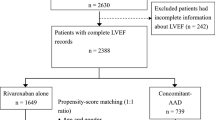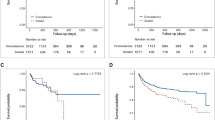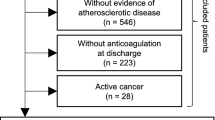Abstract
Outside of clinical trials, the prophylactic effect of dihydropyridine calcium channel blockers (CCBs) on ischemic events in patients with nonvalvular atrial fibrillation (NVAF) has not been confirmed. We compared the effect of dihydropyridine CCBs on ischemic events in anticoagulated NVAF patients. We conducted a multicenter historical cohort study at 71 centers in Japan. The inclusion criterion was taking vitamin K antagonists for NVAF. The exclusion criteria were mechanical heart valves and a history of pulmonary thrombosis or deep vein thrombosis. Consecutive patients (N = 7826) were registered in February 2013 and were followed until February 2017. The primary outcomes were ischemic events and ischemic strokes; the secondary outcomes were all-cause mortality, major bleeding, and hemorrhagic strokes. The mean patient age was 73 years old, and 67% of the patients were male. Seventy-eight percent of the patients had hypertension, and dihydropyridine CCBs were used by 2693 (34%) patients (CCB group). The cumulative incidences of ischemic events and ischemic strokes at 4 years in the CCB and No-CCB groups were 5.9% vs. 5.2% and 5.6% vs. 4.8%, respectively. The adjusted hazard ratios (HRs) (95% confidence intervals [CIs]) of the CCB group for ischemic events and ischemic strokes were 1.22 (0.95–1.57) and 1.32 (1.02–1.71), respectively; the adjusted HRs (95% CIs) of the CCB group for all-cause mortality, major bleeding, and hemorrhagic strokes were 0.85 (0.69–1.04), 1.12 (0.92–1.35), and 1.08 (0.62–1.88), respectively. Dihydropyridine CCB use by anticoagulated NVAF patients significantly increased ischemic strokes in a real-world setting.
This is a preview of subscription content, access via your institution
Access options
Subscribe to this journal
Receive 12 print issues and online access
$259.00 per year
only $21.58 per issue
Buy this article
- Purchase on Springer Link
- Instant access to full article PDF
Prices may be subject to local taxes which are calculated during checkout




Similar content being viewed by others
References
Nabauer M, Gerth A, Limbourg T, Schneider S, Oeff M, Kirchhof P, et al. The Registry of the German Competence NETwork on Atrial Fibrillation: patient characteristics and initial management. Europace. 2009;11:423–34.
Manolis AJ, Rosei EA, Coca A, Cifkova R, Erdine SE, Kjeldsen S, et al. Hypertension and atrial fibrillation: diagnostic approach, prevention and treatment. Position paper of the Working Group ‘Hypertension Arrhythmias and Thrombosis’ of the European Society of Hypertension. J Hypertens. 2012;30:239–52.
Kirchhof P, Benussi S, Kotecha D, Ahlsson A, Atar D, Casadei B, et al. 2016 ESC Guidelines for the management of atrial fibrillation developed in collaboration with EACTS. Eur Heart J. 2016;37:2893–962.
Yamashita T, Inoue H, Okumura K, Kodama I, Aizawa Y, Atarashi H, et al. Randomized trial of angiotensin II-receptor blocker vs. dihydropiridine calcium channel blocker in the treatment of paroxysmal atrial fibrillation with hypertension (J-RHYTHM II study). Europace. 2011;13:473–9.
Mehlum MH, Liestøl K, Kjeldsen SE, Wyller TB, Julius S, Rothwell PM, et al. Blood pressure-lowering profiles and clinical effects of angiotensin receptor blockers versus calcium channel blockers. Hypertension. 2020;75:1584–92.
Eguchi K, Kario K, Hoshide Y, Hoshide S, Ishikawa J, Morinari M, et al. Comparison of valsartan and amlodipine on ambulatory and morning blood pressure in hypertensive patients. Am J Hypertens. 2004;17:112–7.
Wang JG, Li Y, Franklin SS, Safar M. Prevention of stroke and myocardial infarction by amlodipine and Angiotensin receptor blockers: a quantitative overview. Hypertension. 2007;50:181–8.
Ettehad D, Emdin CA, Kiran A, Anderson SG, Callender T, Emberson J, et al. Blood pressure lowering for prevention of cardiovascular disease and death: a systematic review and meta-analysis. Lancet. 2016;387:957–67.
Morimoto T, Uchida K, Sakakibara F, Kinjo N, Ueda S. Effect of concomitant antiplatelet therapy on ischemic and hemorrhagic events in patients taking oral anticoagulants for nonvalvular atrial fibrillation in daily clinical practice. Pharmacoepidemiol Drug Saf. 2021;30:1321–31.
Williams B, Mancia G, Spiering W, Agabiti Rosei E, Azizi M, Burnier M, et al. 2018 ESC/ESH Guidelines for the management of arterial hypertension. Eur Heart J. 2018;39:3021–104.
Elliott WJ, Ram CV. Calcium channel blockers. J Clin Hypertens. 2011;13:687–9.
Gage BF, Waterman AD, Shannon W, Boechler M, Rich MW, Radford MJ. Validation of clinical classification schemes for predicting stroke: results from the national registry of atrial fibrillation. Jama. 2001;285:2864–70.
Pisters R, Lane DA, Nieuwlaat R, de Vos CB, Crijns HJ, Lip GY. A novel user-friendly score (HAS-BLED) to assess 1-year risk of major bleeding in patients with atrial fibrillation: the Euro Heart Survey. Chest. 2010;138:1093–100.
Hicks KA, Tcheng JE, Bozkurt B, Chaitman BR, Cutlip DE, Farb A, et al. 2014 ACC/AHA Key Data Elements and Definitions for Cardiovascular Endpoint Events in Clinical Trials: A Report of the American College of Cardiology/American Heart Association Task Force on Clinical Data Standards (Writing Committee to Develop Cardiovascular Endpoints Data Standards). J Am Coll Cardiol. 2015;66:403–69.
Sacco RL, Kasner SE, Broderick JP, Caplan LR, Connors JJ, Culebras A, et al. An updated definition of stroke for the 21st century: a statement for healthcare professionals from the American Heart Association/American Stroke Association. Stroke. 2013;44:2064–89.
Easton JD, Saver JL, Albers GW, Alberts MJ, Chaturvedi S, Feldmann E, et al. Definition and evaluation of transient ischemic attack: a scientific statement for healthcare professionals from the American Heart Association/American Stroke Association Stroke Council; Council on Cardiovascular Surgery and Anesthesia; Council on Cardiovascular Radiology and Intervention; Council on Cardiovascular Nursing; and the Interdisciplinary Council on Peripheral Vascular Disease. The American Academy of Neurology affirms the value of this statement as an educational tool for neurologists. Stroke. 2009;40:2276–93.
Schulman S, Kearon C. Definition of major bleeding in clinical investigations of antihemostatic medicinal products in non-surgical patients. J Thromb Haemost. 2005;3:692–4.
Butzer JF, Cancilla PA, Cornell SH. Computerized axial tomography of intracerebral hematoma. A clinical and neuropathological study. Arch Neurol. 1976;33:206–14.
Ponikowski P, Voors AA, Anker SD, Bueno H, Cleland JGF, Coats AJS, et al. 2016 ESC Guidelines for the diagnosis and treatment of acute and chronic heart failure: The Task Force for the diagnosis and treatment of acute and chronic heart failure of the European Society of Cardiology (ESC)Developed with the special contribution of the Heart Failure Association (HFA) of the ESC. Eur Heart J. 2016;37:2129–200.
Zamponi GW, Striessnig J, Koschak A, Dolphin AC. The physiology, pathology, and pharmacology of voltage-gated calcium channels and their future therapeutic potential. Pharmacol Rev. 2015;67:821–70.
Umemura S, Arima H, Arima S, Asayama K, Dohi Y, Hirooka Y, et al. The Japanese Society of Hypertension Guidelines for the Management of Hypertension (JSH 2019). Hypertens Res. 2019;42:1235–481.
Terpstra WF, May JF, Smit AJ, de Graeff PA, Havinga TK, van den Veur E, et al. Long-term effects of amlodipine and lisinopril on left ventricular mass and diastolic function in elderly, previously untreated hypertensive patients: the ELVERA trial. J Hypertens. 2001;19:303–9.
Siedler G, Sommer K, Macha K, Marsch A, Breuer L, Stoll S, et al. Heart failure in ischemic stroke: relevance for acute care and outcome. Stroke. 2019;50:3051–6.
Papadopoulos DP, Papademetriou V. Aggressive blood pressure control and stroke prevention: role of calcium channel blockers. J Hypertens. 2008;26:844–52.
Benbir G, Uluduz D, Ince B, Bozluolcay M. Atherothrombotic ischemic stroke in patients with atrial fibrillation. Clin Neurol Neurosurg. 2007;109:485–90.
Acknowledgements
We are indebted to the data managers of the Institute for Clinical Effectiveness (Ms. Makiko Ohtorii, Ms. Ai Sunagawa, Ms. Kaori Yamamoto, Ms. Sachiko Kitamura, Ms. Hirono Saito, and Ms. Saeko Nagano) for managing the data and performing the statistical analyses.
Funding
This study was supported in part by Bristol-Myers Squibb and JSPS KAKENHI (JP21H03176). The funders did not participate in any part of the study from the conception to article preparation.
Author information
Authors and Affiliations
Contributions
FS, SU, and TM: study conception and design. SU and TM: data acquisition and management. FS, NK, and TM: statistical analyses. FS, SU, KU, NK, HA, MN, and TM: interpretation of the data. FS and TM: drafting of the paper. SU, KU, NK, HA, and MN: critical revision of the paper. All authors: final approval of the paper.
Corresponding author
Ethics declarations
Conflict of interest
FS reports paper fees from Medicus Shuppan. SU reports receiving research grants from Bristol-Myers Squibb, Chugai, Kowa, MSD, Pfizer, and Takeda, lecturer fees from Boehringer Ingelheim, MSD, and Taiho, and paper fees from Kowa. He served on an advisory board for Otsuka. KU reports receiving lecturer fees from Daiichi Sankyo, Bristol-Myers Squibb, Stryker, and Medtronic. NK reports receiving lecturer fees from Medtronic and paper fees from Medicus Shuppan. HA and MN have no disclosures to report. TM reports receiving lecturer fees from Bristol-Myers Squibb, Daiichi Sankyo, Japan Lifeline, Kowa, Kyocera, Novartis, and Toray, receiving paper fees from Bristol-Myers Squibb and Kowa, and served on an advisory board for Sanofi.
Ethics approval and consent to participate
The institutional review boards of the University of the Ryukyus (No. 597) and all 71 participating centers approved the study protocol. The institutional review boards waived the need for written informed consent and approved the study following the Ethical Guidelines for Medical and Health Research Involving Human Subjects in Japan.
Additional information
Publisher’s note Springer Nature remains neutral with regard to jurisdictional claims in published maps and institutional affiliations.
Rights and permissions
About this article
Cite this article
Sakakibara, F., Ueda, S., Uchida, K. et al. Association between dihydropyridine calcium channel blockers and ischemic strokes in patients with nonvalvular atrial fibrillation. Hypertens Res 45, 1028–1036 (2022). https://doi.org/10.1038/s41440-022-00855-x
Received:
Revised:
Accepted:
Published:
Issue Date:
DOI: https://doi.org/10.1038/s41440-022-00855-x
Keywords
This article is cited by
-
2023 update and perspectives
Hypertension Research (2023)
-
Can calcium channel blockers prevent ischemic stroke in nonvalvular atrial fibrillation patients?—the optimal choice of antihypertensive drug for subtype-specific stroke prevention
Hypertension Research (2022)



